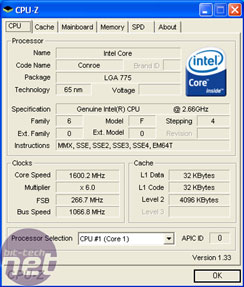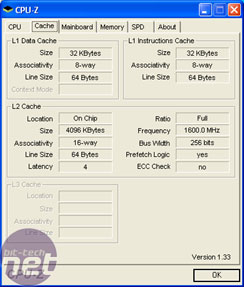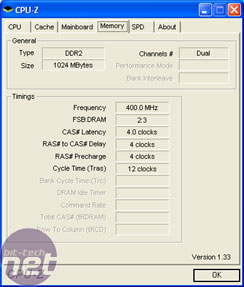
Last month, we were invited to a conference in Munich where Intel gave us the opportunity to run some preliminary benchmarks on one of its upcoming Core 2 Duo desktop processors, based on the eagerly anticipated Conroe core. We were given access to a Conroe-based Core 2 Duo E6700 chip that comes clocked at 2.67GHz – Intel said that this chip is not its flagship desktop processor and is actually a run-of-the-mill clock speed on a 1066MHz front side bus. We are expecting Intel's flagship Core 2 Extreme processor to come clocked at 2.93GHz initially.
The Core 2 Duo benchmarks we ran were not completed in our own labs and we have used some unfamiliar tests in order to establish how well the new Core architecture performs. This was because we were not allowed to tweak the system or install our own benchmarks – the machine was built and configured by Intel engineers.
It came with a selection of industry standard benchmark applications and some popular games too. We ran the same tests on a Pentium Extreme Edition 965 machine built by ourselves when we got back to our offices. This machine had a similar specification, but it wasn’t exactly the same, as we don’t have the same hard drives in our lab.



CPU and memory information for the Intel Core 2 Duo E6700 'Conroe' test system (power management is enabled) - click to enlargeBecause of the outlined circumstances and the fact that the Core 2 Duo chips are not set to launch for another month or two, you should take these results ‘as is’ or ‘preliminary’. We will reserve our final judgements on Conroe’s performance (relative to AMD) until we have independently completed a full set of benchmarks in our own labs on final silicon and BIOS revisions in readiness for Intel’s announcement later this summer.
However, there are some things that we can confirm before the launch. Intel has stated that the Core microarchitecture is a 40/40 architecture; by that it means that the chip is said to be ‘40% faster’ than the current generation desktop products, while ‘consuming 40% less power’. Lets have a look at some numbers.
Intel’s current flagship chip – Pentium Extreme Edition 965 – has a TDP of 130W, while Intel’s upcoming flagship Core 2 Extreme processor is expected to have a TDP of a mere 75W – this means it consumes around 42% less power than its predecessor. Meanwhile, the processor that we are looking at today – Core 2 Duo E6700 – will have a TDP of only 65W and this should enable the Performance-per-Watt metric to be even more impressive.
In comparison, AMD’s current flagship Athlon 64 FX-62 processor has a TDP of 125W. This value should drop when the company migrates its entire product lineup to 65 nanometres, but we doubt that it will be able to compete with Conroe’s expected TDP at the high end. Lets not forget that AMD will introduce ‘energy efficient’ Athlon 64 X2 processors, including a 35W Athlon 64 X2 3800+, and 65W versions of all other Athlon 64 X2’s, with the exception of the X2 5000+.
When comparing TDP values from AMD and Intel, it must be remembered that Intel's TDP is typically quoted as the TDP under normal application mix, whereas AMD quotes maximum TDP in a worst case scenario. When we were given the quoted TDP values for Conroe, details of the how the TDP was measured were not disclosed. We will attempt to do some digging into where Intel has derived ithe quoted TDP values for Conroe from in order to determine whether Conroe's maximum TDP is different to the Intel-quoted value.
NetBurst was meant to scale well beyond the dizzy heights of 10GHz, but it fell a long way short with the highest-clocked NetBurst-based processor shipping at 3.8GHz – the fastest dual core processor that it shipped was the Pentium Extreme Edition 965, which comes clocked at 3.73GHz. Consequently, the fastest-available desktop product has been an AMD chip for some time now – Core looks set to change this, though.
Core has been designed with a completely different mind set, with heavy focus on Performance-per-Clock and also Performance-per-Watt. In fact, the fastest chip that Intel is set to launch when it announces availability of the Core 2 Duo and Core 2 Extreme desktop processors will be clocked at only 2.93GHz. Wil outlined the Core microarchitecture earlier this year at IDF Spring 2006 – we suggest giving the article a read if you’re looking for a bit of a background on the design decisions that Intel’s Israeli chip design team made.
Intel already has products carrying the 'Core' moniker – both its Core Solo and Core Duo chips use the Core moniker, but they are not based on the Core microarchitecture. Yonah is actually the predecessor to the Core microarchitecture and serves as a stepping stone between the single-core Dothan-based Pentium M chips and Core 2 Duo – we recommend giving our Core Duo meets the desktop article a read for an idea of how well Yonah performs against AMD’s K8 architecture at both factory speeds and also clock-for-clock. Conroe shares the same mindset as Yonah, but Intel has improved on many of Yonah’s weaknesses.
Please remember that the Conroe-based system was built and configured by Intel. Both the operating system and benchmarks were installed by Intel performance engineers, so we cannot guarantee that the [i]bit-tech configured operating system was in the same state as the one on the Intel-built Core 2 Duo machine. We were not allowed to make any changes to the Intel-built system.
For our comparison system, we did a clean Windows XP Service Pack 2 installation and used Windows Update to ensure that all of the latest software updates were installed on our machine. The BIOS was tweaked for maximum performance, but PEG Link Mode and all auto-overclock options were disabled.[/i]
The Core 2 Duo benchmarks we ran were not completed in our own labs and we have used some unfamiliar tests in order to establish how well the new Core architecture performs. This was because we were not allowed to tweak the system or install our own benchmarks – the machine was built and configured by Intel engineers.
It came with a selection of industry standard benchmark applications and some popular games too. We ran the same tests on a Pentium Extreme Edition 965 machine built by ourselves when we got back to our offices. This machine had a similar specification, but it wasn’t exactly the same, as we don’t have the same hard drives in our lab.



CPU and memory information for the Intel Core 2 Duo E6700 'Conroe' test system (power management is enabled) - click to enlarge
However, there are some things that we can confirm before the launch. Intel has stated that the Core microarchitecture is a 40/40 architecture; by that it means that the chip is said to be ‘40% faster’ than the current generation desktop products, while ‘consuming 40% less power’. Lets have a look at some numbers.
Intel’s current flagship chip – Pentium Extreme Edition 965 – has a TDP of 130W, while Intel’s upcoming flagship Core 2 Extreme processor is expected to have a TDP of a mere 75W – this means it consumes around 42% less power than its predecessor. Meanwhile, the processor that we are looking at today – Core 2 Duo E6700 – will have a TDP of only 65W and this should enable the Performance-per-Watt metric to be even more impressive.
In comparison, AMD’s current flagship Athlon 64 FX-62 processor has a TDP of 125W. This value should drop when the company migrates its entire product lineup to 65 nanometres, but we doubt that it will be able to compete with Conroe’s expected TDP at the high end. Lets not forget that AMD will introduce ‘energy efficient’ Athlon 64 X2 processors, including a 35W Athlon 64 X2 3800+, and 65W versions of all other Athlon 64 X2’s, with the exception of the X2 5000+.
When comparing TDP values from AMD and Intel, it must be remembered that Intel's TDP is typically quoted as the TDP under normal application mix, whereas AMD quotes maximum TDP in a worst case scenario. When we were given the quoted TDP values for Conroe, details of the how the TDP was measured were not disclosed. We will attempt to do some digging into where Intel has derived ithe quoted TDP values for Conroe from in order to determine whether Conroe's maximum TDP is different to the Intel-quoted value.
Core Architecture – background reading:
The Core microarchitecture is a massive step away from the NetBurst architecture, which relied on high clock speeds – and consequently, high power requirements – in order to attain its performance level across the board. This was all well and good while AMD was shipping its K7 processors, but the situation dramatically changed when AMD launched its K8 architecture in September 2003.NetBurst was meant to scale well beyond the dizzy heights of 10GHz, but it fell a long way short with the highest-clocked NetBurst-based processor shipping at 3.8GHz – the fastest dual core processor that it shipped was the Pentium Extreme Edition 965, which comes clocked at 3.73GHz. Consequently, the fastest-available desktop product has been an AMD chip for some time now – Core looks set to change this, though.
Core has been designed with a completely different mind set, with heavy focus on Performance-per-Clock and also Performance-per-Watt. In fact, the fastest chip that Intel is set to launch when it announces availability of the Core 2 Duo and Core 2 Extreme desktop processors will be clocked at only 2.93GHz. Wil outlined the Core microarchitecture earlier this year at IDF Spring 2006 – we suggest giving the article a read if you’re looking for a bit of a background on the design decisions that Intel’s Israeli chip design team made.
Intel already has products carrying the 'Core' moniker – both its Core Solo and Core Duo chips use the Core moniker, but they are not based on the Core microarchitecture. Yonah is actually the predecessor to the Core microarchitecture and serves as a stepping stone between the single-core Dothan-based Pentium M chips and Core 2 Duo – we recommend giving our Core Duo meets the desktop article a read for an idea of how well Yonah performs against AMD’s K8 architecture at both factory speeds and also clock-for-clock. Conroe shares the same mindset as Yonah, but Intel has improved on many of Yonah’s weaknesses.
Test Systems:
Disclaimer:Please remember that the Conroe-based system was built and configured by Intel. Both the operating system and benchmarks were installed by Intel performance engineers, so we cannot guarantee that the [i]bit-tech configured operating system was in the same state as the one on the Intel-built Core 2 Duo machine. We were not allowed to make any changes to the Intel-built system.
For our comparison system, we did a clean Windows XP Service Pack 2 installation and used Windows Update to ensure that all of the latest software updates were installed on our machine. The BIOS was tweaked for maximum performance, but PEG Link Mode and all auto-overclock options were disabled.[/i]
Intel-built Conroe system:
Intel Core 2 Duo E6700 processor (2.67GHz, 4MB L2 cache, 1066MHz FSB); Intel Desktop Board D975XBX (Intel 975X/ICH7R chipset); 2x512MB Corsair XMS2-8500 DDR2 memory (running at 800MHz with 4.0-4-4-12 timings); ATI Radeon X1900 CrossFire & Radeon X1900XTX running together in CrossFire; Maxtor DiamondMax 10 300GB SATA Hard Disk Drive; Windows XP Professional Service Pack 2; ATI Cataylst 6.3 beta (8.230060131a).bit-tech Presler system:
Intel Pentium Extreme Edition 965 (3.73GHz, 2x2MB L2 cache, 1066MHz FSB); ASUS P5WD2-E Premium (Intel 975X/ICH7R chipset); 2x512MB Corsair XMS2-8500 DDR2 memory (running at 800MHz with 4.0-4-4-12 timings); ATI Radeon X1900 CrossFire & Radeon X1900XTX running together in CrossFire; Maxtor DiamondMax 10 250GB SATA Hard Disk Drive; Windows XP Professional Service Pack 2; ATI Catalyst 6.3 beta (8.230050131a).
MSI MPG Velox 100R Chassis Review
October 14 2021 | 15:04








Want to comment? Please log in.